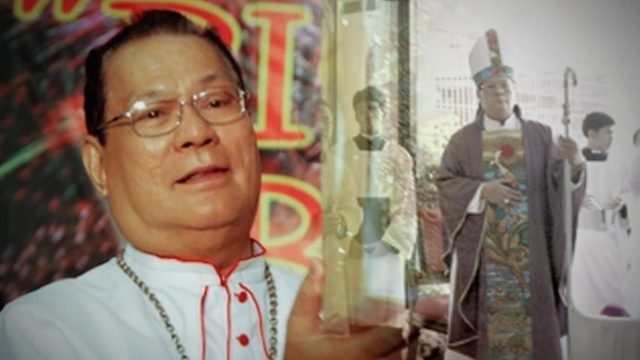SUMMARY
This is AI generated summarization, which may have errors. For context, always refer to the full article.

MANILA, Philippines – Retired Nueva Caceres Archbishop Leonardo Legaspi will be remembered as the one who sought to bring down the Church from its lofty pedestal to one truly for, and of, the poor.
The prelate succumbed to cancer Friday, August 8, four years after he “miraculously” got healed and declared tumor-free by his doctors.
He attributed his healing to the intervention of the Our Lady of Peñafrancia, a wooden image of the Virgin Mary venerated by Filipino Catholics for its miracles and divine intervention.
In January 2009, doctors found tumors in his lungs, prompting Legaspi to undergo chemotherapy.
In an earlier interview by Rappler, Legaspi said he had accepted his fate but that he prayed to the Blessed Virgin to allow him to live long enough to oversee the 300-year celebration of devotion to the Lady of Peñafrancia in 2010.
He got what he wished for and more.
Legaspi announced in August 2010 that he was declared free of cancer, surprising his doctors who found no trace of tumors in his lungs during a regular check-up.
“It was truly a miracle. I had only asked for a year to live longer, but Our Lady extended my fervent wish,” Legaspi said when this writer interviewed him in May 2012.
In that interview, Legaspi was in the pink of health and there were no visible signs of his previous bouts with cancer. In his words, he has “not only recovered,” but even felt “a new lease on life.”
Redefining role of the Church
Highly regarded and deeply respected by his colleagues, the prelate is regarded as the brains behind the Second Plenary Council of the Philippines (PCP-II), which brought together all stakeholders in the Church to redefine the role of the Church, lay leaders, and the religious in society.
In 1988, Legaspi, who was at that time president of the Catholic Bishops’ Conference of the Philippines (CBCP), asked then recently-resigned Archbishop Oscar Cruz to get the pulse of the laity and the religious on what direction the Church should take.
Less than a renewal of faith, the prelate felt it was the best time to renew Church engagement in society.
“I though it was a good time to reassess and redefine our role. The relationship with the State was good, unlike during the Marcos time when the relationship with the Church was turbulent. It was a good time to reflect and identify issues that the Church can confront as a whole,” Legaspi said during the interview.
Cruz said he went around the country to discuss the planned plenary, “taking note of what subject matter they would like to be discussed.” Cruz was tapped as the secretary-general for the planned PCP-II.
“PCP-II was unique in the sense that it was the first plenary in the world after the Second Vatican Council and after the New Code of Canon Law was implemented,” Cruz said in a separate interview.
In January 1991, PCP-II was convened, participated in by 96 bishops, 181 priests, major religious superiors, rectors and lay leaders. It was a gargantuan gathering where participants “stayed in” for a month to finish the PCP-II documents, Cruz recalled.
In this gathering, participants resolved to transform the Church into a “Church of the Poor,” with preferential option for the poor as overarching theme.
“The overall intention is a Church of the Poor in the sense that there is material detachment. Do not cling to what you have and practice faith along the lines of generosity,” Cruz explained.
Church of documents
But like many Church documents, PCP-II failed to live up to its promise.
In 2012, during a National Clergy Assessment, Legaspi’s brainchild was weighed and found wanting – more than 20 years after PCP-2 was approved and adopted.
The general observation was that the Church of the Poor which PCP-2 envisioned was found deficient.
The most telling sign of the Church’s failure to transform itself as Church of the Poor was EDSA 3, according to then Cagayan de Oro Archbishop Orlando Quevedo, who was named cardinal in January 2014. “EDSA 3 demonstrated how little we have progressed toward the PCP-2 vision. For all the dioceses in the Philippines, EDSA 3 was a wake-up call.”
Cruz agrees that PCP-II got waylaid. “PCP-II got the approval of the Vatican. It had high expectations, but nothing happened,” he said.
In the earlier interview, Legaspi said that while PCP-II visions were not fully fulfilled, the consolation was that the seeds of change had been planted.
He agreed that a third plenary should be convened, this time taking into consideration the myriad changes in Philippine society.
Brilliant man
Asked how he will remember Legaspi best, Cruz said, “Archbishop Legaspi was a brilliant man with superior management skills.”
For a time, Legaspi was considered to succeed the then-ailing Manila Archbishop Jaime Cardinal Sin to fix the mismanagement in the Archdiocese of Manila.
He also investigated the abuse scandal in a seminary in Bulacan which led to the resignation of one bishop.
Legaspi retired from active Church service in 2012 and in the twilight of his years, “he wanted to do ordinary things beyond the limelight,” Cruz said.
“We talked about it and he said just wanted to hear confessions.” – Rappler.com
Add a comment
How does this make you feel?
There are no comments yet. Add your comment to start the conversation.